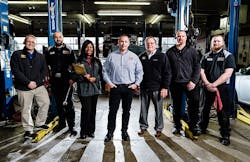Creating the Right Staff for Your Multi-Location Shop
SHOP STATS: Toledo Auto Care Location: Toledo, Ohio. Operator: Gary Pontious Average Monthly Car Count: 375 (Monroe St.); 275 (Heatherdowns Blvd.) Staff Size: 22 (Both shops combined) Shop Size: 5,000 square feet (Monroe St.); 275 (Heatherdowns Blvd.) Annual Revenue: $2.5
Without a leader, who can the team look to for success? At Toledo Auto Care in Toledo, Ohio, shaping staff members into knowledge-driven, hard-working team players is what makes the multi-location shop stay open today.
“It’s my goal to be the Chick-Fil-A of auto repair,’” says general manager of Toledo Auto Care, Gary Pontious Jr. “If you’ve been to a Chick-Fil-A, you know that the customer experience is different than any other fast food experience.”
Following overstaffing issues that occured once the business nearly doubled in size from 2006 to 2015, Pontious took a step back to determine what he wanted his shop culture to consist of and how he would create success from employees. Pontious took time to examine what was needed for the company to grow and said reading and researching helped him land on answer that has helped morph the business: build your company culture.
In 2016, Toledo Auto Care decided to make the investment in an additional, second location for the company and ultimately push for growth. The new shop, located on Heatherdowns Blvd. in Toledo, was an acquired business with an existing staff who would later be retained by their now predecessor.
“My initial goal and focus started with customer experience and hasn’t wavered since,” Pontious says. “One of the things that I was interested in was leadership and [focusing on] leadership development as a niche for my company,” Pontious says.
With two storefronts open today and plans for an additional third underway, the auto repair business has experienced how to properly navigate a team through new ventures by offering standardized training methods and the creation of a company culture that continues to retain as the business develops.
Start With A Leader
Prior to opening the second location, Toledo Auto Care was franchised, he says, and in an effort to help new hires, the shop went through and wrote down processes within the shop and updated all of the businesses manuals.
“Bringing over two key staff members is one big thing; in opening the second location, I believe that the general manager of the company, or myself, should be spending at least six months up to a year regularly involved in that new location so that we’re establishing our culture, reinforcing our team leader, and establishing our culture,” Pontious says. “Bringing over a team leader is pretty critical for the culture being established.”
Opening the additional store taught Pontious a lot, he says.
“You need to have a key manager and a team leader position and you need to have at least one technician that’s been in your organization at least over a year,” Pontious says.
It’s important to bring in staff members that are familiar and comfortable with the shop’s processes when opening a new location.
Arrive With A Process
In order to provide customers with a positive experience, your shop has to first identify their overall company culture, he found.
“To have that good company culture, you have to hire well and learn how to find these people that are going to fit into your culture, and how you do things is important,” Pontious says. “Companies tend to hire someone for what somebody knows and fire for who they are; what I’ve tried to do is turn that around and train them on what they know and what they don’t know.”
In the shop, success derived from a set staffing procedure that was created all by trial and error following overstaffing issues, Pontious says.
Today, his employees are hired around a set model: two advisors for every four technicians.
Upon acquiring the second location, Pontious met with staff members with the previous business and discussed the opportunity of working for the repair shop.
“We did retain the staff,” Pontious says. “We met with them individually and walked through our process and how we do things, our pay programs and stuff at the time, which I’ve [now] tweaked. We needed to retain them to keep the business functional.
“We made a year commitment to [the retained staff] to grow and develop them, and to give them every opportunity to accumulate them into our culture.”
Spend Time With Hires
When employees start at the business, he or she will spend the day with Pontious as a way to get acclimated with the company culture.
“We make sure that everybody’s first day is usually spent with me and it’s not spent on the shop floor,” Pontious says. “They get to know who we are, what we do, and I usually take them to Chick-Fil-A for lunch because the restaurant is very experience-oriented.”
Those employees are not forgotten by Pontious after their first day either, he says.
“To have that good company culture, you have to hire well and learn how to find these people that are going to fit into your culture, and how you do things is important,” Pontious says. “Companies tend to hire someone for what somebody knows and fire for who they are; what I’ve tried to do is turn that around and train them on what they know and what they don’t know.”
Create Internal Staff Partnerships
When employees are hired at the business, Pontious puts new hires in an onboarding training process that encourages growth and continued education, he says. Over the last six months, Pontious has worked to finetune the onboarding program, which caters to both technicians and service advisors.
Following the first day, technicians and service advisors experience two separate onboarding processes, he says.
“For technicians, what we do is put them with another technician and they work with them for usually 2–3 days and they get acclimated on our digital inspections and just how we do things,” Pontious says.
Advisors spend the first couple of weeks with Pontious when they’re in the beginning stages of learning how the shop works.
“[After] we begin to acclimate them into the store, they still come back once per week [to the hub location where Pontious works] to review phone calls,” he says. “They do that for a month every week. Then, for every three weeks they’re coming in, they do personal reviews.”
About the Author

